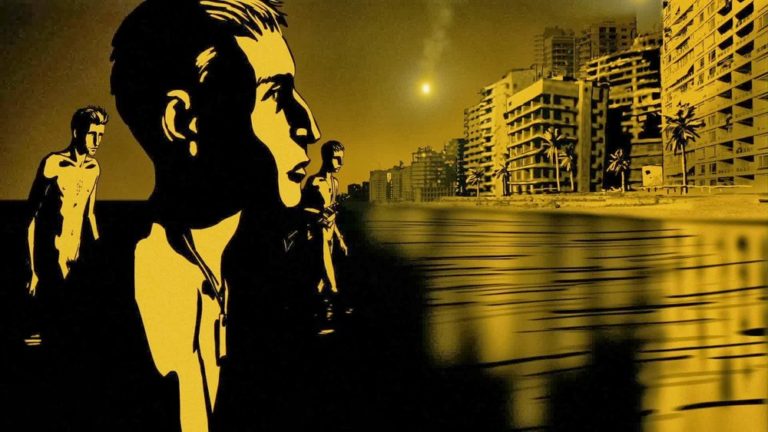Between May 2007 and May 2008, two animated feature films each falling under the guise of the animated documentary genre placed front and centre the representation of conflict in the Middle East. Animation of conflicts and war was new and looked like a paradoxical idea, inviting criticism.
Released almost exactly a year apart and both premiering at the Cannes Film Festival, Persepolis (Marjane Satrapi & Vincent Paronnaud, 2007) and Waltz with Bashir (Ari Folman, 2008) both exploited the animated medium’s expressive potential to ‘work through’ and provide access to an objective historical truth that remains frustratingly unobtainable. In both films, animation is made to bear the weight of social reality, with its images not simply loaded with claims to the real but anchored to stark memories of national trauma.
Staging encounters with the historical real, Persepolis and Waltz with Bashir engage spectators through their status as animated memoirs of sorts. They narrate images of the Middle East while arousing political debate over their complex representations of Palestinian and Arab culture. The Iranian state-run Farabi Foundation, for example, protested to the French Embassy in Tehran over the screening of Persepolis at the Cannes Film Festival. Waltz with Bashir was banned in Lebanon, though not in Beirut’s Hamra district.
Telling an Autobiographical Story Through the Animated Documentary Genre
Premiering at Cannes on May 23, 2007 (and released in the U.K. almost a year later), Persepolis is based on Marjane Satrapi’s own autobiographical graphic novels Persepolis and Persepolis 2 (originally published in November 2000), which concern a young girl growing up in Tehran around the time of the 1979 Iranian revolution.
In the first Persepolis graphic novel, Marjane tells the story of the first ten years of her life until the overthrow of the Shah regime and Pahlavi dynasty, and the outbreak of the Iraq-Iran war. Born in 1969, Satrapi describes the war as the historical backdrop for her own teenage development, before leaving the country for Vienna at the age of fourteen.
The follow-up, Persepolis 2, deals with her subsequent exile in Austria, Satrapi’s high-school years and education in the Austrian capital, and her subsequent return to Iran where she married, divorced and then moved to France, where she now resides.
Folman’s Waltz with Bashir offers a similarly anecdotal space of catharsis, and as with Persepolis, it is an autobiographical account in which missing memories are realised in a distinct and abstracting animated style. Widely credited as the first feature-length animated documentary, Waltz with Bashir follows Israeli filmmaker Folman as he undertakes a personal quest to regain his memories of the Sabra and Shatila massacre in Beirut, which involved the slaughter of 3500+ Palestinian and Lebanese civilians in refugee camps across 2 days in September 1982.
What connects Persepolis with Waltz with Bashir is the role of the animated medium in marshalling how we engage with and recognise historical (and personal) ‘truth’, at the same time as knowing that the events depicted are a product of striking graphic representation.
Folman stressed that when it came to whether Waltz with Bashir should be animated, there was “no other way to tell this story”. The film self-consciously mixes real historical events and audio recordings of real-life interviews (conducted by Folman) with an animated aesthetic. This makes us more fully aware of how we experience representations of war, violence and suffering as often heavily mediated events.

A central question that surrounds animated documentaries such as Persepolis and Waltz with Bashir is whether the animated formal style dilutes or fully supports the power, impact and weight of the subject matter. Does animation save and reclaim historical events from potential irrelevancy and cultural amnesia, or render them even more incomprehensible?
Matching the global expanse of its source material, the film adaptation of Persepolis (directed by Satrapi, alongside French comic book artist Vincent Paronnaud) utilises animation to zigzag with ease between time periods, fluidly moving in its disruptive chronology between past and present, Iran and Europe, to create a deliciously mischievous portrait of life in exile melded with a more familiar coming-of-age narrative.
The combination of autobiography and graphic novel with animation – if not the proximity between Satrapi’s real life and the events depicted onscreen in Persepolis – both affirms and threatens the animated documentary as a category, causing it to be in flux. Yet the film shares with Waltz with Bashir an urgency of truth and a claim to legitimacy that seem to bypass the presumed artificiality of animation as a medium. Instead, it promotes its stories as bracingly authentic despite the medium used to represent it.
Somehow the truthfulness of both films works best in the pared down, ‘personal’ animation they adopt throughout. Both Persepolis and Waltz with Bashir tell us that individual or even collective national memory can be fluid and changeable, unreliable and incoherent, rather than a concrete set of recollections.
The Films’ Graphic Style: How Animating Works
The starker, predominantly black and white graphic style in Satrapi and Paronnaud’s film exploits the “crude” aesthetic of traditional animation that has been (to a degree) outmoded since the arrival of digital technology.
Such a visually striking style evokes the aesthetics of the original graphic novels and the bande-dessinée (“drawn strip”) pictorial format in France, with occasional shifts in design serving to visually distinguish the film’s chronology. The result is ‘lo-fi’ animation, largely in black-and-white, that is exploited in a narrative ostensibly about a little girl growing up in pre-revolutionary Iran in the 1970s.
Waltz with Bashir equally obtains its impact from a more limited, flattened style of 2-D animation. Animated using a combination of Adobe Flash cut-outs and more traditional cel-animation, Folman’s feature occupies an earthy colour palette of browns and yellows, laying bare in its jerky character movements the kinds of imperfections that are often eradicated by the pristine illusionism of computer graphics.
This is a kind of animation that seems to bear the scars of historical trauma on its own body.

If Waltz with Bashir’s heightened political climate certainly seems well-served by its distinctive animated style, then a similar interplay between form and content no less informs the narrative of Persepolis.
The film opens in Paris’s southern Orly airport, and a scene in which the now-adult protagonist, Marji, waits to depart for Iran, though she is unable to board her plane. Persepolis then jumps back to her early pre-teen life, in which she irreverently adopts the ferocious martial arts and kung-fu poses of idol Bruce Lee as a clue to her lively and determined constitution.
With the onset of the political revolution setting in motion the country’s move towards an Islamic Republic, such childlike frivolity is soon replaced with the looming silhouettes of clamouring mobs, images of smoke plumes and teargas pellets launched at the Shah’s doomed regime. The literal veiling of the country through social, economic and political reform – and of course the literal veiling of its women through Ayatollah Khomeini’s implementation of compulsory hijab – is just one of the markers of the revolution that Persepolis seeks to depict.
The Iranian Revolution was a culmination of diverse political ideologies and principles, and the veiling of Iranian women, who were also active in the Revolution, prompted them to pour into the streets in protest at the blatant injustice of the Islamic regime. In Persepolis, then, Marji often feels as though she is a foreigner in her own native country, and regularly seeks respite from feeling forlorn and powerless.
The film, through its animation, therefore serves to ‘unveil’ her own story and award it a degree of truth, while for Folman the very production of Waltz with Bashir likewise gives him the chance to come to terms with – and authenticate – his personal trauma.
Memory in Transition
The animated worlds that protagonists Marji and Folman occupy is ultimately one of transition and mobility.
Waltz with Bashir conjures a meandering narrative through twentieth-century Israeli history, albeit one that uses subjectivity to exacerbate the importance of forgetting. Folman’s ability to remember is marked by gaps limiting his consumption of information, and the film becomes more about failing memory than the veracity of a specific national-historical moment.
In this respect, telling his story in animation makes it perfect. But it also makes the abrupt shift to live-action archival recordings (following a climactic revelation of Folman’s complicity in the Sabra and Shatila massacre) all the more potent, which confirms the character’s movement back into historical reality.
In Persepolis too, events are re-enacted and dramatized in ways that fully embrace Marji’s increasing agency. For example, the journey that she takes from Tehran early in her childhood, through teenage years spent in Vienna and back in Tehran, and then adulthood in Paris, is one that unfolds more explicitly across national borders. It is anchored to images clearly emphasising themes of departure and arrival, and of journeys ending and beginning. There are also recurring images of windows and doorways among its visual regime.
At the heart of Persepolis lies this explicit in-betweenness that has its roots in national identity and history. Marji is an exilic and transcultural character or bicultural subject torn between her homeland and a multitude of hostlands. Her political maturation is matched to her occupation of interstitial or marginal spaces.
If Waltz with Bashir plots Folman’s gradual acquisition of historical knowledge, then Persepolis similarly takes its main narrative cue from the physical, intellectual and artistic growth of Marji, delighting in both her feminist exuberance and fundamentalist repression, here played out in all its strikingly monochromal, flattened beauty.
Animation is entirely (and wonderfully) fake, false and artificial by token of the fact the camera is not used to record reality. Instead the medium artificially creates its own. A drawn universe resists realism as a mode of representation, and yet can remain about social reality in a thematic sense.
The intention to create ‘documentaries’ in animation as in Persepolis and Waltz with Bashir is inhibited by the fact that the animated medium cannot be objective or observational in the same way as a documentary. Yet animation can take the viewer to locations, to spaces, and to experiences that are unreachable through conventional photographic means.
Animation is an industrial art form, but it is also a form of therapy and rehabilitation as a consequence of its fundamentally metaphorical or symbolic potential.
Persepolis and Waltz with Bashir confront head-on the Iranian Revolution and Lebanon war respectively, but do so by using animation to ‘make sense’ of the turbulence and chaos endemic to these tumultuous historical narratives. Perspective on Middle Eastern history and the intangible spectres of cultural memory are therefore obtained through the filtering properties of an animated medium, one whose creative and expressive potential is ultimately equally well-served by the traumas that it is made to depict.
Editor’s Note: The opinions expressed here by Impakter.com columnists are their own, not those of Impakter.com – In the cover picture: Movie still from Persepolis









